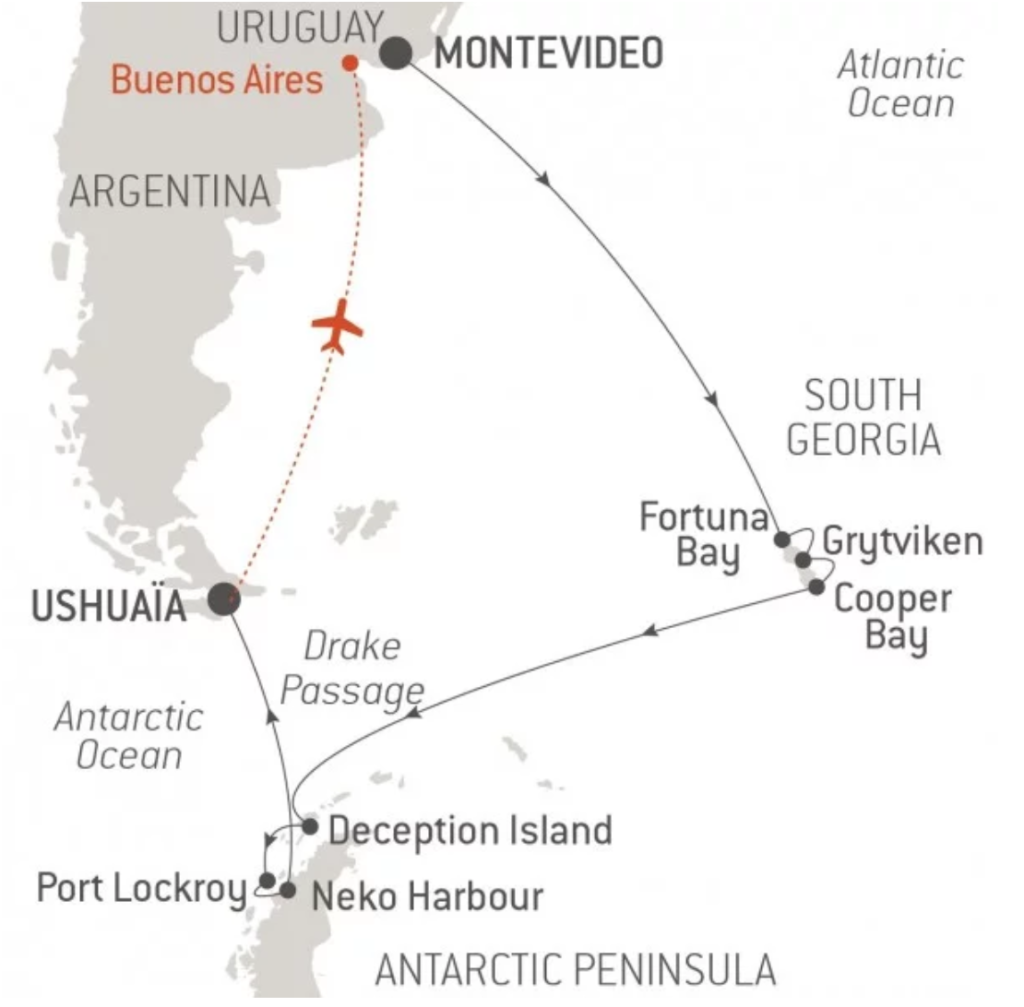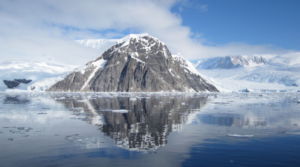The Great Adventure – from Montevideo
Itinerary Map

Follow in the footsteps of the great explorers during a crossing between South Georgia and the Antarctic Peninsula. Leaving from Montevideo, you will set sail for a 16-day expedition cruise into the heart of the White Continent.
Begin by discovering the coastlines of South Georgia, an island deeply marked by its whaling activity of the past. In Fortuna Bay, set off to meet the immense colony of king penguins, the real rulers of the roost. Your stop at Grytviken will enable you to relive the adventures of Sir Ernest Shackleton, the famous British explorer who lies here, before setting sail for the Antarctic Peninsula.
Don’t miss out on the shore visit to Deception Island, which long served as a refuge for sailors during heavy storms. You will come across elephant seals and fur seals, sharing the spotlight with chinstrap penguins. You’ll then go to Port Lockroy where you’ll be surprised to find a small museum and the most southern post office in the world.
You will disembark in Ushuaia, the Argentinean capital of Tierra del Fuego, whose landscapes will take your breath away.

Length of Travel: 16 Days
Itinerary in Brief
- Day 1: Montevideo – Embarkation
- Days 2 to 5: At Sea
- Day 6: Fortuna Bay
- Day 7: Grytviken
- Day 8: Gold Harbor / Cooper Bay
- Days 9 & 10: At Sea
- Day 11: Deception Island
- Day 12: Wilhelmina Bay / Port Lockroy
- Day 13: Paradise Bay / Neko Harbor
- Days 14 & 15: Drake Passage
- Day 16: Ushuaia – Disembarkation
Detailed Itinerary
Day 1: Montevideo - Embarkation
Perched on the far southern tip of Uruguay, Montevideo is a white city, and one of the loveliest capital cities of South America. Come and admire the beautiful historical remains dating from Spanish rule; you’ll find the most interesting within the Cuidad Vieja, formerly fortified, its old town dates from the 18th century. The best preserved are the cathedral and the former governmental palace of the Cabildo, both listed historical monuments. In the crook of a vast blue bay, the city is also blessed with beautiful beaches.
Days 2 to 5: At Sea
Day 6: Fortuna Bay
Situated at the foot of sharply-rising mountains, Fortuna Bay is a truly dazzling vision to behold. You’ll marvel at a panorama of cliffs rising up from the icy waters and small streams fed by melting mountain snow meandering through vast green plains. The bay itself bows inward to form a perfect crescent, indented by a torrent. During your excursion, you can follow in the footsteps of Ernest Shackleton or even encounter the 50,000 king penguin couples who call the island their home and whose densely-packed silhouettes form a remarkable silver swath with a sprinkling of brown and bright orange.
Day 7: Grytviken
The Grytviken stopover is a highlight of South Georgia Island. This former whaling station, now a ghost town, is set against a serene backdrop of ochre-colored earth. Vestiges of the whaling industry are still very much present, particularly old whale bones and remnants of shipwrecks. Grytviken’s other historical point of interest is the grave of famous adventurer Sir Ernest Shackleton. During the legendary Endurance expedition (1914-1917) Shackleton and his men survived against all odds after having been trapped in pack ice for several months. The series of exploits leading to their rescue will remain forever etched in the annals of Antarctic exploration.
Day 8: Gold Harbor / Cooper Bay
Majestic glaciers with a bluish sheen, waterfalls that reflect the rays of the setting sun, pitch-black volcanic sand beaches: these are just a few of the wonders to be found in Gold Harbor’s landscape. This natural gem is blanketed by bright green tussocks and framed by snow-capped peaks. On this island where summer days are endless, the wildlife stays up with the sun. Fur seals, elephant seals and king penguins move about the island like tiny black dots along the landscape. Those humans who enter this kaleidoscope of colors and sensations do so as privileged and tolerated observers of the austral wildlife.
Explore Cooper Bay, near Gold Harbor. It was named after the first lieutenant of the famous sailor, Captain James Cook, and the bay offers a quite unexpected sight, with long basalt canyons forming high cliffs that loom over a turquoise-blue water. In the center of the bay, a magical atmosphere reigns when just a few rays of sunshine pierce the gauzy layer formed by the morning mist. The craggy coastlines are home to colonies of macaroni penguins who pay close attention to the arrival of our tiny crafts.
Days 9 & 10: At Sea
Day 11: Deception Island
Situated just above the northern tip of the Antarctic Peninsula, Deception Island is easily recognizable thanks to its distinctive horseshoe shape. The crater of this former volcano caved in 10,000 years ago and the resulting caldera was flooded, creating a natural harbor. Deception Island still bears traces of its past as a longtime hub of the whaling industry. The vestiges of abandoned sheds that line the black sand of its volcanic beaches share space with the island’s spectacular fauna: it is home to the Antarctic Peninsula’s largest colony of chinstrap penguins, as well as numerous elephant seals and fur seals.
Day 12: Wilhelmina Bay / Port Lockroy
Between 1897 and 1899, Belgian explorer Adrien de Gerlache led an Antarctic expedition aboard the Belgica. There, he discovered a quiet, protected bay which he named in honor of the Dutch queen, Wilhelmina of Orange-Nassau. In this enchanting place, towering mountains reflect off still waters, offering up a magnificent and colorful feast for the eyes. Yet another source of wonder: humpback whales, majestic and frequent visitors to the bay, feed in the surrounding waters amidst a stunning seascape of ice floes and icebergs.
Port Lockroy is a spectacular natural harbor nestled in the very heart of the Antarctic Peninsula on Goudier Island. Discovered by French explorer Jean-Baptiste Charcot in 1903, the site has served over the years as a stopover for whaling ships, a British military base and later a research station. The port is currently one of the most visited sites in the Antarctic, thanks to its tiny museum which allows visitors to experience the base as it was in the 1950s and to take home a souvenir from its gift shop. While you’re here, don’t miss the chance to send your loved ones a post card from the southernmost post office in the world!
Day 13: Paradise Bay / Neko Harbor
With its spectacular landscapes composed of towering glacial peaks plunging down into the icy waters of the Antarctic, Paradise Bay is true to its name. Discovered and named by whalers in the early 20th century, this protected natural site is currently home to a wide variety of fauna, from Antarctic cormorants and leopard seals to sheathbills and gentoo penguins, who mingle on the long stretch of rocky beaches. With some luck, you’ll even be privy to an unforgettable underwater dance between passing humpback whales. During your excursion, head off to discover the old Argentine base Almirante Brown, which is only occupied for a few weeks each year, during the austral summer.
A little corner of paradise in the shadow of a towering glacier, Neko Harbor is without a doubt one of the most beautiful sites on the Antarctic Peninsula. It was discovered by Belgian navigator Adrien de Gerlache during his 1897-1899 expedition. Mountains, ice and wildlife combine to form a truly unique landscape. Animals are as abundant as they are exotic: among others, you’ll encounter seabirds (gulls, Cape petrels, cormorants) and marine mammals (seals, orcas and other whale species). Head out on a Zodiac excursion to get up close to the icebergs, stop over near a penguin colony, watch a leopard seal sunbathe between dives and enjoy an impromptu aerial show from passing Antarctic terns.
Days 14 & 15: Drake Passage
If there is one place, one sea, one waterway dreaded by tourists, researchers and hardened seafarers alike, it is undoubtedly the Drake Passage. Situated at the latitude of the infamous Furious Fifties winds, between Cape Horn and the South Shetland Islands, it is the shortest route to Antarctica. Seasoned navigators will tell you that you must earn your visit to the White Continent! As a convergence zone where cold currents rising up from the South Pole meet warmer equatorial water masses, Drake Passage harbors a very diverse marine fauna. Don’t forget to look to the sky to catch a glimpse of elegant albatross and Cape petrels, playfully floating about in the wind around your ship.
Day 16: Ushuaia - Disembarkation
Capital of Argentina’s Tierra del Fuego province, Ushuaia lies in a bay opening into the Beagle Channel at the country’s southernmost tip. Its colorful houses are framed against towering mountains, snow-capped in winter and summer alike. Downtown, the End of the World Museum showcases Tierra del Fuego’s natural and indigenous history. A ride on the heritage railway is an exciting excursion into the Tierra del Fuego National Park, while a cruise on Ushuaia Bay is the perfect way to spot sea lions and Magellanic penguins.


